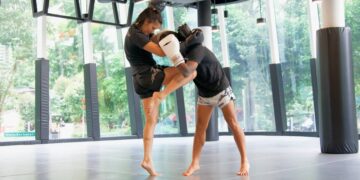
Sweeps are some of the highest-scoring techniques in Muay Thai. Knocking an opponent’s legs out from under them and sending them crashing to the canvas requires exceptional timing and skill. The mere sight of you standing over your grounded opponent can often sway the judges and secure a close round in your favor.
Since a single sweep can undermine the efforts of an entire round, no one wants to risk getting swept. However, considering sweeps are often executed as a defense against essential techniques like the body kick, it is nearly impossible to compete in Muay Thai without several sweep defenses in your arsenal.
Luckily, with the right skill set and approach, it is possible to attack the body relentlessly while preventing yourself from getting swept by even the most skilled opponent. In this article, we’ll share three simple yet effective strategies for landing your body kicks while preventing yourself from getting swept to the canvas. So, if you ever find yourself with your back on the canvas every time you attempt a body kick, read on, this article has every piece of information you need to know to avoid getting swept the next time kick!
The Standard Catch And Sweep
While Muay Thai offers a wide variety of sweeps, the standard catch and sweep as a defense to the body kick is by far the most common. Body kicks are the most common weapon in Muay Thai and trying to fight without them usually puts you at a huge disadvantage. For this reason, we are focusing on defending against this kind of sweep in the next few paragraphs.
We’ll refer back to this footage of former ONE Bantamweight Muay Thai World Champion, Nong-O Hama demonstrating the catch and sweep with Evolve instructor, Penaek Sitnumnoi throughout this article, so we recommend studying it thoroughly before reading on.
Sweep Defense #1: Concealing Your Kick Behind Punches
The best way to avoid the standard over-catch and sweep is to stop your opponent from catching your kick in the first place. Without first catching your kicking leg, your opponent will have a smaller window to kick out your supporting leg. Therefore, the best way to avoid this kind of sweep is to ensure that your opponent’s hands are too busy to catch your leg when you kick.
In the above video, Penaek kicked Nong-O without concealing the attack behind punches. Because of that, Nong-O was in a good position with his hands free, ready to defend. Simply punching toward your opponent’s head just before you kick can often be enough to prevent them from catching the kick, as their arms will be raised to defend their head, potentially obscuring the kick from their view. The punches before the kick also push your opponent onto their back leg, making it much more difficult to sidestep and catch the kick. Many fighters won’t risk attempting the catch if they can’t step away to reduce the impact on their ribs.
Sweep Defense #2: “Pulling” Your Kick
In the above demonstration you will notice that when Nong-O catches Penaek’s kick, Penaek’s foot is tucked behind his armpit. This is vital for a catch and sweep as the foot acts as a ‘plug,’ stopping Penaek from being able to break free his leg caught by Nong-O’s grip. Therefore, Nong-O would only be able to pull this sweep off in a real fight scenario if Penaek kicked at a range where his foot traveled past his body.
In a fight where effective scoring is crucial, you don’t necessarily want to kick so that your foot connects with your opponent’s body instead of your shin. Sure, in traditional scoring, every body kick will score you points regardless of whether your foot or shin connects, but kicks that cause damage will certainly score higher. As a result, you’ll want to prioritize using your shin as much as possible.
“Pulling” a kick when it is about to be caught is the perfect way to balance the need to land a kick with power while avoiding being swept if your opponent attempts to catch your leg.
To do this, kick your opponent with the intent of battering them with your shin and, if you see them moving their arm to catch you, pull your leg back by bending at the knee so that only your foot connects with your opponent’s ribs. It will still score under many rule sets and, even if your opponent has the right skill and timing to catch, your foot will still be able to slip easily from their grip as you pull it back, making the catch and sweep impossible.
Sweep Defense #3: The Knee Guard
The knee guard defense, demonstrated in the above video by Chaowalit Jockygym. is often used to stop an opponent from being able to knee you in the clinch, but this technique can also be appropriate in situations where your leg gets caught to avoid being swept.
To perform the knee guard when your leg gets caught, simply turn your leg horizontally as your opponent scoops it under their armpit so that your toes are pointing across their back rather than up into their armpit. Then, bend your leg at the knee and hop towards your opponent so that your shin is pushed across the waistband of their shorts. This will stop them from being able to step through to sweep you.
As you hop, secure your arms into a clinch and then, with your hands tied, pull their head towards you while pushing their hips away from your shin. You must do this to break your opponent’s posture as they may still be able to sweep you if they are standing upright.
In the above catch and sweep demonstration you will notice that Nong-O lifts Penaek’s leg high into his armpit and leans back after he catches it, breaking Penaek’s posture. If your opponent does this it makes knee-guarding across the hips almost impossible. Therefore, you need to transition to the knee guard quickly. As they are still scooping your leg, you can often avoid being swept by swiftly pulling your foot back.
You may also like:
Nabil Anane: A Towering Force In Muay Thai
In Muay Thai, laying traps can be risky business. Even with all the right skill, technique, and planning, they are still a gamble; can you subversively impose your will on your opponent? Will you be…
In Muay Thai, Muay Mat is an aggressive and powerful breed of Nak Muay who specialize in delivering powerful punches to inflict damage on their opponents. As punches are a conditionally scoring technique under the…
Speed is an important aspect of any sport. Being able to move faster than your opposition can react is a surefire key to victory whether you’re playing non-contact sports such as football or tennis, but…
Grips are an important and necessary part of the Muay Thai clinch. While some fighters may prefer to grab the arms in order to control their opponents and maintain the space needed to throw elbows,…
Have you ever struggled to corner an evasive opponent in the ring? Or are you sick of getting kept out of striking range by a taller opponent’s teep? Whenever you need to close distance quickly…
Kickboxing and Muay Thai training typically starts with learning the basics strikes like jabs, teeps, and roundhouse kicks. Once you’ve gotten the basic strikes used in Kickboxing down, it’s time to move on to basic…
When working out, building significant muscle mass takes dedication, hard work, and time, so you want to do everything possible to maintain your new physique. The last thing you want is for your newly gained…
Brazilian Jiu-Jitsu is a martial art that thrives on both offensive and defensive techniques. The turtle is considered as one of the premier positions in the art and is known as a tough position to…
Signing up for martial arts like Muay Thai, Brazilian Jiu-Jitsu (BJJ), and Boxing helps you to lose weight in more ways than one. Engaging in intense exercise, such as martial arts training, provides a significant…
In Singapore’s ever-busy and fast-paced urban landscape, sleep often feels like a luxury rather than a necessity. While much of the city’s energy is fueled by ambition and productivity, sleep deprivation has quietly become an…
Fans of ONE Championship’s Friday Fights at Lumpinee Stadium will be familiar with the name Nabil Anane. Standing at 192 cm, the Thai-Algerian is not only one of the tallest fighters in the ONE arena…
The world of Brazilian Jiu-Jitsu is filled with many unique techniques and positions. One of the things that set BJJ apart from other grappling arts is the fact that Jiu-Jitsu allows more freedom to fight…

































